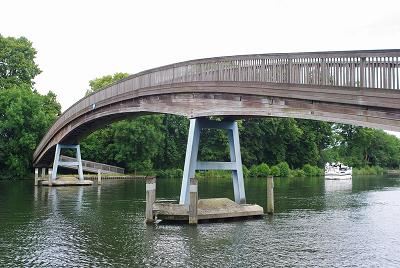Temple
 Temple Footbridge
Temple Footbridge
A rustic footbridge takes me back over from the island to resume the walk to Marlow. It does not seem that far before the towpath switches sides again. Until 1989 this particular crossing provided a major problem for walkers wanting to follow the river downstream. A ferry used to operate here but has been out of action since 1953 and walkers had to leave the riverbank and follow the road through Bisham in order to get to Marlow.
The problem was resolved in 1989 with the construction of Temple Footbridge which sweeps across the river to deliver the walker to the towpath on the north bank. At 150 feet across this is the longest wooden footbridge in Britain.
The area name is derived from the Knights Templar who owned Temple Mill Island, the mill and the surrounding lands. The mill once boasted the largest millwheel on the entire river, but it is no longer here. It was demolished to make way for the development of a marina towards the end of the 1970’s. The mill had a complete working history until then. Originally built as a flour mill, it changed to a copper foundry in about 1710. This was made possible because the opening of the Thames and Severn Canal enabled copper to be carried by barge all the way from Swansea. The foundry then turned the copper into pots, pans and kettles in both copper and brass. In 1848 the manufacturing switched to brown paper and this continued until 1969 when the mill finally closed.
The Templars were also largely responsible for the next major building along the opposite bank, Bisham Abbey. There is evidence that the Templars occupied a building here from at least 1139. The building was considerably expanded around 1260. When the Templars were suppressed in 1307 the preceptory and its surrounding lands were confiscated by Edward II and granted to his various relatives. In 1310 the Priory was used as a place of imprisonment for Elizabeth Queen of Scots, the wife of Robert the Bruce. Elizabeth had been captured, along with her along with her stepdaughter Princess Marjorie and sister-in-law Lady Christine of Carrick, during the Scottish Wars of Succession. All three were placed in custody under the direction of the King’s Yeoman, John Bentley. They stayed at Bisham Abbey for two years before being transferred to Windsor Castle.
In 1335 the manor was purchased by William Montacute, the Earl of Salisbury, and it became the Salisbury family home for many years. Montecute founded Bisham Priory immediately next to the house, and the foundation stone was allegedly laid by Edward II. William Montecute was buried at the Abbey, as are several of his ancestors.
Another key figure from history is also buried here. Richard Neville, probably better known as “Warwick the Kingmaker” was also buried here in 1471 shortly after the Battle of Barnet.
The Priory was dissolved in July 1537, but only six months later was revived as a Benedictine Monastery by some monks who had been displaced from Chertsey. These monks were hopeful of being left in peace because they were dedicated to praying for the late queen, Jane Seymour. However, this was not to be, and they were forcibly evicted after only six months. When he was being dragged out of the chapel the Abbot, John Cordery, cursed the building, calling on God to witness that it should never be inherited by direct successors because some calamity would always befall the sons of those who later owned it. Nothing is now to be seen of the chapel or its associated monastic buildings.
The manor house was given to Henry’s fourth wife, Anne of Cleeves, as part of her divorce settlement. Anne in turn exchanged the house with Philip Hoby for his house in Kent. The house remained in the Hoby family for many years.
The Abbey is now run by Sport England as a hotel, conference and training complex for elite sportsmen and women. Over twenty different sports regularly use the facilities, including the England football and rugby teams and individual sports such as tennis and judo.
< Previous Page | Next Page >